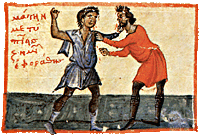Causes and forms of social conflict
 n the late Byzantine period, the social conflicts became more intense as the antagonism between the aristocracy and the other classes grew stronger.
n the late Byzantine period, the social conflicts became more intense as the antagonism between the aristocracy and the other classes grew stronger.
 The main cause for this animosity was the concentration in the hands of the dynatoi ("powerful") of the land ceded to them by the state and the consequent expoitation of the rural population by these powerful landowners. The opposition expressed by the farmers was related, each time, to the conditions then prevailing in each region, while its intensity depended on whether the presence of the political authority in the area was strong or weak. The main cause for this animosity was the concentration in the hands of the dynatoi ("powerful") of the land ceded to them by the state and the consequent expoitation of the rural population by these powerful landowners. The opposition expressed by the farmers was related, each time, to the conditions then prevailing in each region, while its intensity depended on whether the presence of the political authority in the area was strong or weak.
Outbreaks of violence had already been observed since the beginning of the 13th century in the
Despotate of Epiros and the state
of Nicaea. Historical sources of the time inform us that very often landowners and farmers clashed when the latter tried to regain - not infrequently by forceful means - their ancestral rights to the land. On other occasions, farmers are known to have refused the payment of taxes or the execution of private corvees (angareiai) demanded by the landowners. It would even seem that there were instances in which private citizens or even entire communities went so far as to resort to legal means in order to denounce their exploitation by the landowners. Moreover, a number of peasants abandoned their lands in protest against the oppression to which they were subjected.
Particularly
violent incidents occurred during the civil wars of 1321-28 and 1342-47 - during periods, that is, in which the political authority was facing a deep crisis and was forced to impose harsh economic measures on a population that was already on the brink of total destitution.
See also: 1st Civil War
2nd Civil War
|